Think pie pastry is daunting? Try this 3-ingredient wonder
By Debra Samuels
| GLOBE CORRESPONDENT -October 8, 2013
Leslie Fishman says the recipe for apple pie she learned from her mother “became a family favorite for decades.” Her daughter is the third generation to make it.
NEWTON — At some point everyone wants to try making America’s iconic dessert, apple pie. Just the thought of crafting a crust can be daunting. But not if that crust contains only three ingredients — flour, vegetable oil, and orange juice — and not if you’re pretty much guaranteed a crisp and tender pastry that cuddles a filling of not-too-sweet and spiced apples. And not, finally, if the dessert is really easy as pie.
Newton resident Leslie Fishman has just such a recipe. It comes from her late mother, Serena Weinstein, who learned it when her husband, Frederic, enrolled in the Framingham Heart Study in the early 1950s. Fishman’s oil-based crust, which is so moist you have to roll it between sheets of waxed paper, bakes into incredibly flaky pastry. She’s perfected it over 40 years.
In a red dress in her all-white kitchen, Fishman, who describes herself as a “woman of a certain age,” stands out like a berry in snow. At her marble-topped island, using her mother’s rolling pin with its deep patina, she flattens a piece of dough into a thin round between two sheets of wax paper, then lifts off one piece, and in a single movement flips the round over a pie plate. As the dough settles into the shape of the dish, she removes the remaining wax paper layer and announces, “See, it peels off effortlessly.”
Into a mixture of sliced apples — Golden Delicious, Braeburn, and Honeycrisp — she tosses flour and cane sugar crystals instead of granulated because cane has a deeper caramel-like flavor. Then she fills the dough with apples, sprinkles on cinnamon and nutmeg, and cuts small pieces of butter randomly over the fruit.
The top crust goes on pretty much like the bottom one, with the same flipping motion. Fishman tucks, crimps, and brushes the top with a glaze made from milk. She sprinkles the pie with the cane sugar crystals, cuts vents, and sends it into the oven.
After 40 minutes, she slips the tip of a knife into the apples to see if they are soft. “Sometimes this pie can take over an hour,” she says. The finished pie is beautifully browned and glistening with sweet, crunchy sugar crystals.
When Fishman’s father was in the Framingham Heart Study, which tracked the relationship of diet and lifestyle to cardiovascular disease, the staff provided participants help in achieving a healthier regime. Fishman says that the wives of participants were required to attend nutrition and cooking classes given by then Boston-based food purveyor S.S. Pierce & Co. The apple pie, with its low-cholesterol crust, was among many her mother learned. “Although my father didn’t end up staying with the study, the pie became a family favorite for decades,” writes Fishman in an e-mail.
In the 1980s, Fishman taught “Easy as Pie” classes for Newton Community Education and twice took first place in a citywide baking contest. Her winning confection also captured the heart of Ralph Fishman, a widower, when she was divorced and placed a personal ad in a local paper stating she liked making apple pies. He called, they met, and she baked him a pie. “He was hooked,” she says. They were together for 13 years until he passed away last summer.
The simple pie dough is nearly identical to one created by Wesson Oil in the 1920s (that version uses milk instead of orange juice). These crusts don’t require chilling, extra flour for rolling, or ginger handling. For the crust cognoscenti, they’re a revelation, for the newcomer a gift.
Frederic Weinstein’s participation in the Framingham study, says his daughter, “kept our cholesterol levels very low all these years and both my parents lived a wonderful life until the age of 95½.”
Now Fishman’s daughter Jessica Walitt, an architect in San Francisco, makes the pie.
Three ingredients in a no-fail pie crust are entering the third generation.
RECIPE
Makes 1 deep 9-inch pie
“My mother knew this recipe like she knew her name,” says Leslie Fishman. This no-fail pie dough — made with flour, oil, and orange juice — bakes into a crisp crust. Fishman uses Golden Delicious, Braeburn, and Honeycrisp apples; you can also use Baldwin, Cortland, Mutsu, or Northern Spy. Flour, tapioca, and cornstarch are traditional thickeners for fruit pies; this one uses flour.
PASTRY
| 2 | cups flour |
| ½ | cup orange juice |
| ½ | cup vegetable oil |
2. In a bowl with a rubber spatula, mix the flour, orange juice, and oil until the dough comes together.
Knead in the bowl for 20 seconds. Divide into 2 pieces, 1 a little larger than the other.
3. Roll the larger piece of dough between the sheets of waxed paper to a 12-inch circle (some may be outside the paper; that’s OK). Carefully peel off the top paper. Lift the pastry and paper and flip them onto the pie dish. Peel off the paper. Press the pastry evenly into the dish; set aside.
FILLING
| 7 | large baking apples, peeled, cored, and cut into ¼-inch slices or ½-inch chunks |
| 1 | tablespoon lemon juice |
| ¾ | cup cane sugar |
| ¼ | cup flour |
| ½ | teaspoon ground cinnamon |
| ⅛ | teaspoon ground nutmeg |
| 1 | tablespoon butter |
| 1 | tablespoon milk |
| Extra cane sugar (for sprinkling) |
1. Set the oven at 425 degrees. Line a rimmed baking sheet with parchment paper.
2. In a bowl, toss the apples and lemon juice.
3. In a separate bowl, combine the sugar, flour, cinnamon, and nutmeg. Sprinkle the sugar mixture over the apples and toss well. Heap the apples in the pie dish, leaving a mound in the middle. Dot the apples with butter.
4. Peel off the top paper from the remaining pastry. Flip the pastry onto the apples. Peel off the paper. Turn the pastry edges under onto themselves, like a hem, around the rim. Crimp the edges of the top and bottom rounds together. With a fork, press the edges to seal them. Brush the pastry with milk and sprinkle with sugar. With the tip of a paring knife, make 6 small slits in the dough.
5. Set the pie on the baking sheet. Bake for 15 minutes. Turn the oven down to 350 degrees and continue baking for 50 minutes. The pie should be nicely browned; the juices will bubble up through the slits. Total baking time is 65 minutes.
6. Cool on a wire rack for at least 30 minutes.

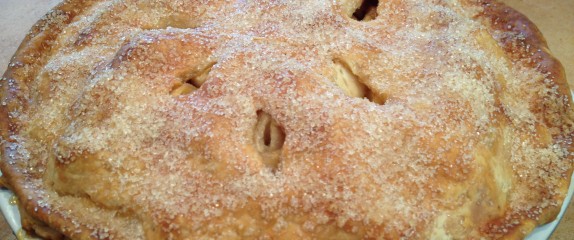
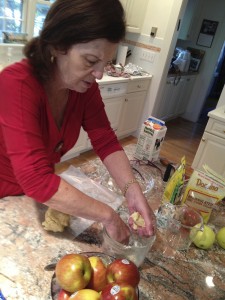
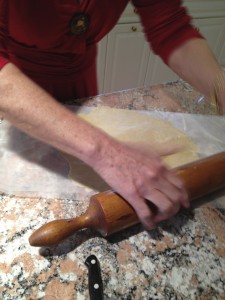
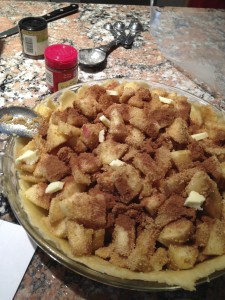
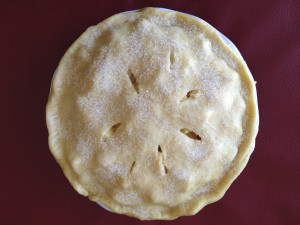
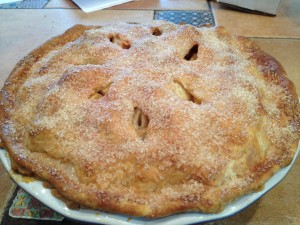
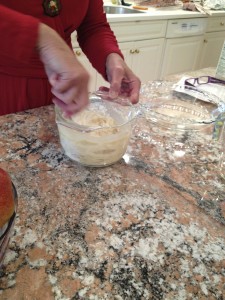
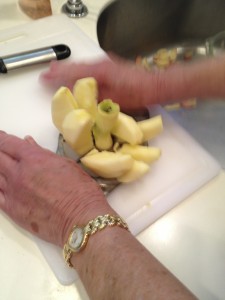










 Debra Samuels, bestselling author, food writer and cooking instructor,
Debra Samuels, bestselling author, food writer and cooking instructor,